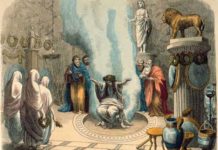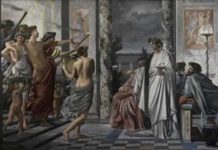At the beginning of the fifth century BC, the Achaemenid Persian Empire was the most powerful state in the Ancient Near East.
The term ‘Achaemenid’ actually comes from the name of the ancestor of the ruling dynasty, who was supposedly a man called ‘Achaemenes’.
Not much is known about the early history of the Persians. Before the sixth century BC, there is no real mention of them.
The only important peoples that we hear about living in the country known as Iran today were the Medes and the Elamites. Both of these peoples are mentioned as enemies in the records kept by the Assyrians.
The Medes, in fact, played a significant role in the final destruction of the Assyrian Empire.
Then, in about the middle of the sixth century BC, Cyrus the Great, who was the founder of the Persian Empire, conquered in turn the Medes, the Lydians and the Babylonians. By the end of his reign, the Persians were in control of all of Anatolia, Mesopotamia, the Levant and much of Central Asia in addition to the whole of Iran.
Much is made of the ‘greatness’ of Cyrus by later writers (including Herodotus), but we cannot be sure how much of this is factual. It does seem pretty certain that a lot of the material written about him is legendary.
For example, Herodotus gives us an account of how he had been left to die of exposure as a baby because it had been predicted that he would usurp the throne when he grew up. The similarity of this story to several others (e.g. the story of Oedipus) cannot but shed doubt on its historicity.
Cyrus was succeeded by his son Cambyses, who extended his father’s conquests by adding Egypt to the empire.
After the death of Cambyses there was a brief period of instability. Cambyses was eventually succeeded by one Darius.
We cannot be sure who Darius was. One modern theory is that Darius was actually a usurper who had assasinated Cambyses’ brother Bardiya who should by right have succeeded to the throne.
Darius continued the tradition of his predecessors by making further conquests.
By about 500 BC, the Persian Empire was at the peak of its power. In addition to all its territories in Asia and Africa, it also had taken over the Greek city-states of Ionia (the eastern coast of the Aegean Sea).
Herodotus
Herodotus is widely known as the “Father of History”. He was first given this title by the Roman statesman Cicero.
Although this term is still widely used today, even by respected scholars, it is not entirely accurate and is simply a manifestation of the Hellenocentric orientation among academics.
For example, we know that the early history of the Israelites was in all probability compiled at least a hundred and fifty years before Herodotus. A renowned Biblical scholar, Profesor Baruch Halpern, has convincingly argued that this early history of Israel, known among scholars as the Deuteronomistic History and comprising the biblical books of Joshua, Judges, Samuel 1 and 2, and Kings 1 and 2, is a genuine attempt at history-writing and that therefore the authors of these books (whoever they may have been) should actually have the claim to being the ‘First Historians’.
Whether or not they got their facts right is a debatable (and passionately debated) point, but it is important to remember in this context that Herodotus got a lot of his facts mixed up as well.
Herodotus was not himself an Athenian but was actually from Halicarnassus (modern Bodrum), which was a city-state on the Asian side of the Aegean Sea. We cannot be sure as to when exactly he was born but it would have been from about 495 to 480 BC.
Herodotus is known mainly for his work ‘The Histories’ which he is thought to have written some time between 440 and 420 BC. This is a long and complex work, which includes details about the early history of the Persian Empire, Egypt and the Scythians.
There are a lot of inaccuracies in Herodotus’ work and even in Antiquity, this had already gained him the additional title “Father of Lies”.
For example, in one part of his work, Herodotus describes the hippopotamus as a creature that lives in the river Nile and has “a horse’s mane and tail”.
Probably the most well known inaccuracy in Herodotus’ works is the portrayal of Cambyses and of his relations with his Egyptian subjects.
Herodotus tells us not only that Cambyses was a ruthless despot but also that he deliberately alienated the Egyptians by actually stabbing the sacred Apis bull with his own dagger.
We now have archaeological evidence that indicates that Cambyses went to pains to portray himself as an Egyptian pharoah in order to ingratiate himself with his Egyptian subjects. We also have the remains of a sacred Apis bull that Cambyses had interred in the proper tombs in the Serapeum in accordance with all the correct religious traditions.
Most scholars today do not consider that Herodotus deliberately set out to mislead his readers, but only that he was just too ready to believe whatever he was told by his sources.
It is possible that the biased portrayal of Cambyses that we find in Herodotus is due to his having been told a highly negative version by the Egyptian priests from whom he supposedly got these details.
The Ionian Revolt
In 499 BC, the Greek city-states of Ionia rose in revolt against their Persian overlords.
Herodotus characteristically gives us a cloak-and-dagger version of events in his ‘Histories’.
What we can be sure of however is that two of the leaders of the revolution were Histiaeus, the ruler of the city-state of Miletus, who had been taken away to the Persian capital of Susa by Darius (presumably as a hostage) and one Aristagoras, who was ruling Miletus in his stead.
Aristagoras first organised the revolt in Ionia against the Persians, then set sail to Mainland Greece in order to enlist the aid of the Spartans and the Athenians.
Although his request for aid was turned down by the Spartans, it was received favourably by the Athenians, who dispatched a force of twenty ships to help their fellow Greeks in Ionia.
Reinforced by these Athenian ships and a further contingent of five ships from Eretria (a Greek city-state on the island of Euboea), the Ionians launched an attack against the local Persian capital of Sardis. Herodotus tells us that the Ionian rebels actually razed Sardis to the ground.
The Persian response to these events was determined and vigorous. Even before the news of the attack on Sardis had reached Great King Darius in far-away Susa, the local Persian forces had caught up with the Ionian rebels and decisively defeated their army near Ephesus.
After this reverse, no further help was forthcoming from Athens and Eretria, but the Ionian cities fought on heroically. They were unable, however, to last for long against the superior military resources of the Persians.
Finally, in 494 BC, the Persians took Miletus and burned it to the ground in revenge for the razing of Sardis. This effectively ended the Ionian revolt.
The Battle of Marathon
Darius now decided that he had to teach the Athenians and the Eretrians a lesson.
He accordingly gave orders for a Persian force to cross the Aegean Sea and punish the two city-states for having dared to give help to the Ionian rebels. The Persian forces were commanded by a Median commander named Datis, who was accompanied by one Artaphernes, a nephew of Darius.
According to Herodotus, the Persian forces had at their disposal six hundred triremes. As will be seen later, Herodotus’ figures are not always reliable.
We have no definite information as to what sources Herodotus used in coming up with his estimates. If he simply used the Athenians own estimates of the numbers of their opponents, then it is possible that these figures may have been wildly exaggerated.
Thucydides, who wrote about the later Peloponnesian War, records that the great Sicilian expedition launched by the Athenians in 415 BC, which he describes as ‘the most costly and finest-looking Hellenic force…ever’, numbered no more than 150 ships.
The Persian expeditionary force set sail across the Aegean, put in briefly at Delos, where Datis ‘burned three hundred talent-weight of frankincense’ at the temple of Apollo, and finally reached Eretria.
The Eretrians had already asked for help from the Athenians and received four thousand men from them. They defended their city for six days, but eventually, the Persians got the upper hand. Eretria was taken, and its temples were burned to the ground.
Datis now took his forces across to the mainland.
The Persians landed their army at a place called Marathon. Here they were met by the Athenian army, commanded by ten generals, one of whom was an able strategist named Miltiades.
Herodotus tells us that the Athenians had petitioned the Spartans for aid. The Spartans, however, were late in arriving, and the battle was joined without them.
The Persian army was thoroughly defeated by the Athenians.
According to Herodotus, only 192 Athenian casualties were sustained, whereas 6400 Persian were killed.
Xerxes and the invasion of Greece
Darius was succeeded as Great King by his son Xerxes in 486 BC.
On his accession to the throne, Xerxes was faced by revolts in both Egypt and Babylonia. He spent the first few years of his reign putting down these revolts. Having attended to these matters, he decided to lead his army to mainland Greece to finally settle what to the Persians would have been seen to be ‘the Aegean Problem’.
Herodotus’ estimates of the size of the army that Xerxes put together for his invasion of Greece are so exaggerated that very few modern scholars take them seriously. He claims that the army alone (excluding the naval contingent) numbered 1.7 million men. The total of Xerxes land and sea forces he estimates at exactly 2,317,610.
In other words, Xerxes’ total invading force would have been slightly larger than the entire German Armed Forces at the beginning of the First World War.
Modern estimates of the size of Xerxes army run from about 60,000 to 250,000 men.
Xerxes led his forces across the Hellespont in 480 BC.
As the invading Persians approached, a general panic took hold of the Greek city-states. Some of the Greeks decided to throw in their lot with the Persians. Among these were the Thebans and the Thessalians.
But thirty-one of the Greek city-states, including Athens and Sparta, formed a league to resist the invaders. A force was despatched to hold the Persians at a narrow pass called Thermopylae, under the command of the Spartan king, Leonidas.
The traditional account of the following battle (which derives mainly from Herodotus’ version) is a highly romanticised version of how a small number of defenders held off the vastly superior Persian army, thereby saving Greece and all of ‘Western’ civilisation.
Whatever the real events, the actual result was that the defenders were massacred and the Persian army continued on its slow but unstoppable march southwards.
The Battle of Salamis
Having overcome the defenders of Thermopylae, Xerxes’ army proceeded into Greece.
Herodotus records that one part of the Persian army was dispatched to destroy the sacred city of Delphi. In his version of events, the advancing Persians were suddenly struck by thunderbolts from the sky, and by two massive rocks that had been torn off from Mount Parnassus. The Persians then fled in panic and the Delphians came out of their city and routed them.
As the Persians approached, the Athenians frantically debated their next move.
A prediction had been given to the Athenians by the Delphic Oracle that ‘the wooden wall’ would save Athens.
Some Athenians took this to mean that they should literally construct a wooden wall around the Acropolis and that this would be their salvation. Others interpreted this as meaning that Athens would be saved by her fleet, and accordingly evacuated the city.
Xerxes army took possession of the city of Athens, the fortified Acropolis was taken by storm and the defenders massacred. The temples on the Acropolis were burned to the ground by the invading Persians.
Xerxes triumphantly dispatched a rider to Susa to proclaim his victory but he was assuming too much. The mere act of taking Athens had not ended the war, for the Greek fleet was still in existence.
What happened next is again highly conjectural. Herodotus as usual gives us a highly dramatised version of events. In his account the Athenian admiral Themistocles tricks Xerxes into attacking the Greek fleet just before all the allied ships dispersed. It is equally possible that the over-confident Persians stupidly attacked the Greek fleet, not expecting any serious resistance now that they had “won”.
Whatever the truth of Herodotus account may be, there is no doubt that the Persian fleet was thoroughly defeated by the combined naval forces of the Greek city-states at the following battle of Salamis.
Not only do we have the accounts of both Herodotus and the tragedian Aeschylus about the massive naval losses sustained by the Persians, but we do not see the Persians capable of any serious naval action for many years after this event.
The aftermath of Salamis
With his fleet destroyed, Xerxes had no choice but to withdraw to Asia with the major portion of his army.
Herodotus describes Xerxes’ cowardice in graphic detail, but it is difficult to see what other course of action would have been available to him.
A large army is not easy to keep supplied and this problem would have been even more acute in ancient times, when the logistics of supply would have depended on animal drawn carts.
Without command of the sea, any army that was too large to support itself by foraging was doomed to starve to death.
We also know that there actually was a revolt in Babylonia a year later in 479 BC. It is possible that Xerxes decided to withdraw most of his forces from Greece in order to be better able to deal with events closer to Persia itself.
A part of the remaining Persian force was left behind in Greece under the command of one Mardonius, however, in order to continue the fight.
Sporadic fighting continued, but with the defeat at Salamis, the course of events had been determined.
A year later, a combined Greek army under the command of the Spartan general caught and destroyed Mardonius’ army near Plataea.
Xerxes grand expedition to subjugate the Greeks had come to a sorry end.








